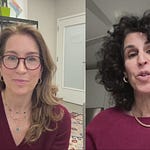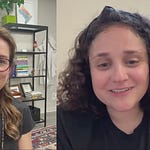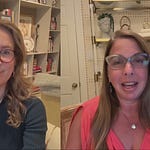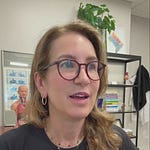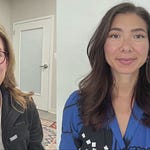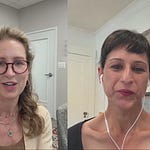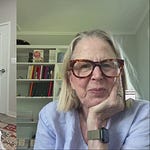You can also check out this episode on Spotify!
Twice a month, Dr. McBride is trying something different. She will talk directly to you — sharing advice and top-line thoughts about the most important health issues she sees.
On this 13-minute episode, Dr. McBride explains the practical framework she created to help patients conceptualize their health, integrating medical evidence, the patient’s story, and real life.
Dr. McBride calls it the FOUR “I”s
Information & data = the elements of our health that we can measure and see.
Inputs = everything that we put into our health ecosystem.
Infrastructure = the vehicle (i.e., the skeleton) that drives us through life.
Insight = the process of laddering up from self-awareness to acceptance to agency over our health and well-being.

Helping people connect the dots between their own four “I”s lays the groundwork for improved physical and mental health.
Join Dr. McBride every Monday for a new episode of Beyond the Prescription.
You can subscribe on Apple Podcasts, Spotify, or on her Substack at https://lucymcbride.substack.com/podcast. You can sign up for her free weekly newsletter at lucymcbride.substack.com/welcome.
Please be sure to like, rate, review — and enjoy — the show!
Disclaimer: The views expressed here belong entirely to Dr. McBride. They do not reflect those of her employer, nor are they a substitute for advice from your personal physician.
The transcript of the show is here!
Dr. Lucy McBride: Hello, and welcome to my home office. I'm Dr. Lucy McBride, and this is, "Beyond the Prescription." Today, it's just you and me. Every other week this season, I'll talk to you like I do my patients. Pulling the curtain back on what it means to be healthy, peeling back the layers of everyday medical problems I see. In clinical practice for over 20 years, I've found that patients generally want the same things. A framework to evaluate their [00:00:30] risks, access to the truth, and the courage to face it, and tools, and actionable information to be healthy mentally and physically. So, whether it's managing weights, cholesterol, cancer, or mental health issues, we all want to feel more in control of our health. Here, I'll talk to you about how to be a little more okay tomorrow than you are today, and how to be healthy from the inside out. Let's go.
Welcome to our first one-on-one [00:01:00] meeting. I'm so excited to be here. I love talking to my guests. I've also been craving this kind of direct conversation where I can help strip some of the complex things I see in my office down to the studs, and then try to explain the way I frame various health issues, and then give people tools, and information to manage those issues in their everyday lives. As you know, I strongly believe that health is about more than just our lab tests, right? Our stories live in our bodies, [00:01:30] and the data that we can collect is only useful when we marry it with our lives, our stories, our pasts, and when people have access to nuanced information about how to take information, and apply it to their everyday existence. So, let's start with something really basic. I use a very simple graphic when I'm explaining to patients how I conceptualize health.
It's really, really simple. It's a two by two square. I'm not much of an [00:02:00] artist, but I can print out a box on my computer like a grid. If you're in your bed or sitting in a comfortable chair, maybe you want to close your eyes and imagine a two by two square. If you're driving, don't close your eyes, but maybe in your mind's eye, you can imagine this visual representation. So, what is it? I've called this graphic, "The Four I's." Why, "The Four I's?" Because I think of patients as the integrated sum of these different quadrants. The first I is information. [00:02:30] The second is inputs. The third is infrastructure. And the fourth is insight. So, imagine this, two by two square. In the top left corner, you have information, in the top right corner, you have inputs. In the bottom left corner, you have infrastructure, and the bottom right corner, you have insight.
If I've lost you, and you've fallen asleep, good for you. You probably needed a rest, but if you're still with me, I'd love to [00:03:00] keep going. Let's talk about the top right corner, information. Information is data, so things we can measure, from our cholesterol, our mammogram, our colonoscopy report, our genetic testing to look for our predisposition for breast cancer. Basically, information is the box where we put all the things that doctors love. Data, metrics, things we can quantify. Frankly, modern medicine does a really good job of helping people quantify all that data, right? [00:03:30] Patients love data so much that they're walking around with trackers to track their steps, their sleep, their moods, their energy, and then people have trackers to track their trackers, right? That's why all of these apps are so popular. The problem is that information, medical data in a vacuum isn't terribly useful.
We need context. So then, let's move over to the top right quadrant, inputs. Inputs are everything you put in your ecosystem, everything you put in your body, [00:04:00] whether it's kale and quinoa, or alcohol and marijuana. Every single thing that we ingest has impact on our bodies. Even things that are "natural," like supplements and vitamins, those things have direct effect on our everyday health. So, when I'm talking to a patient, I don't simply review their data, check their medical information, the data, and go through it like a checklist and tell them, "Great news, these look fine. See you next year." I contextualize it. In other words, I need to [00:04:30] know this top right corner. What are you putting into your ecosystem? What are you ingesting? Whether it's food, alcohol, vitamins, supplements, cigarette smoke, marijuana, cocaine, whatever it is, we needed to talk about it, and we needed to go over it.
The bottom left quadrant is infrastructure. This is, literally, your skeleton, the actual container that drives you through life. Remember, you only have one vehicle that takes you through life. You cannot trade your skeleton in like you can your Honda or your Prius. [00:05:00] Maintaining your skeletal health is essential for mobility, flexibility, pain control, general movement, and of course, exercise which is good for everything from diabetes to dementia. Okay, if you're still here with me, let's keep going. The bottom right quadrant is insight. Now, when I say insight, I mean self-awareness, awareness of the inseparability of your mental and physical health, and frankly, the whole ecosystem I've just gone [00:05:30] over. It's about understanding where you are on the continuum of anxiety. It's about locating yourself on the continuum of moods. It's about understanding your relationship with alcohol and food. It's about understanding the way you process stress, the way you handle relationships with work, with partners, and with yourself.
Insight is crucial, and insight informs how we think about the whole ecosystem. It informs how we [00:06:00] think about meaning, and purpose, and our lives in context. In sum, "The Four I's" is a visual representation of how I conceptualize health. It's very helpful. I have found for patients to look at each quadrant alone, and then in concert with the other quadrants. Because inevitably, they all talk to each other. Let's take, for example, someone who has high cholesterol. So, they have a data point that would go in the top left corner that they have high cholesterol. [00:06:30] I can say to that person all day long, "Eat less bacon, exercise more, your cholesterol's too high. I'll see you in a year." You know, that would be fine recommendation, but frankly, I don't believe in shaming people. I don't believe in telling people what to do. I believe in giving them the tools to help themselves.
More importantly, to appropriately counsel this patient, I would have to look at all the context. I would have to look at the other pieces of the puzzle, the other I's. And when I talk [00:07:00] to the patient, and I understand that their top right quadrant, their inputs, include the absence of dietary fiber, an abundance of food at the very end of the day, after a long day of not eating adequately, that's important to know. It's not just what they eat, it's the cadence of their habits and their everyday eating behaviors. I also need to know that in the bottom right quadrant, they've had a recent hip injury. As a result of hip pain, they've been sort of not sleeping [00:07:30] so well. They've been taking more Advil, and they've been feeling kind of rotten, and as a result of the Advil, they're not eating as much healthy food.
And then, you go to the bottom right, insight quadrant. And I find out the patient hasn't really fully acknowledged how much the hip pain is interfering with her sleep, how it's causing her to take Advil, and then, how much she's actually missing exercise to help with her mental health and well-being, which is then prompting her to eat more haphazardly if that's a word. In other words, [00:08:00] addressing that insight and calling attention to the basic fact that the absence of exercise, plus pain, plus Advil use, plus dietary haphazardness, that's the mechanism by which she has high cholesterol, honestly, helps the patient understand the whole ecosystem.
And then, without shaming and blaming her for being human being, I can then talk to her about, "let's try to figure out how to manage this hip. Let's not just limp along literally and metaphorically [00:08:30] with Advil. Let's actually work on your pelvic floor, which is weak, and then driving the hip pain. Let's get you into a good body mechanic, just like you take your car to the shop if a tire was misaligned, you also wanna take your vehicle, your skeleton to the shop, to work on that hip rotation to make sure you're not in pain, to get you back in action with your everyday life. To then think about structuring your everyday eating habits, to make sure you're [00:09:00] getting a really good high-fiber, high-protein, low-fat lunch, really hit that metabolic engine middle of the day to then go to a 4:00 snack, and then have a smaller dinner where you can go to bed, not so overly full, wake up hungry, and then, that sets you up for eating a higher fiber, lower cholesterol diet." In other words, the wrong thing, in my opinion, to do is simply to look at a piece of data, a cholesterol level, and tell people, [00:09:30] "Eat less, exercise more."
That is not actually treating the patient, that's treating the number. I hope that makes sense. That's just an example of a common phenomenon I see in my office. It's also an example of how easy it is, honestly, so easy to take care of a patient when you listen to their story. When you help them connect the dots between their physical selves, their mental health, their everyday inputs, and then, you give them the information to help improve their data, and their everyday [00:10:00] quality of life. At the end of the day, it is really great to have low cholesterol. Low cholesterol means that you're at lower risk in general for heart attack, and stroke, and cardiovascular disease. It is equally important, arguably more important, to have a sense of agency over your everyday health. To have the tools and information on how to make small but sustainable, and realistic changes in your life, to be healthy from the inside out.
Merely, helping someone recognize that the [00:10:30] cadence of their eating is one of the problems that they're facing and that their hip is a solvable problem, not with Advil, but by addressing the root cause, is really, really empowering, and is honestly very, very easy. Here's what I recommend to you. Take a grid of paper, draw a four square. In the top left corner, write information. In the top right corner write inputs, in the bottom left corner write infrastructure, the bottom right corner [00:11:00] write insight. And in each of those quadrants, just jot down some notes. Write down what pieces of data your doctor has told you he or she wants you to work on. Write down what pieces of data are unfortunate fixed realities in your life. Perhaps, you have the BRCA gene that puts you at higher risk for breast cancer. Perhaps you are dealing with colon cancer, Parkinson's, or some other medical condition that you do not have control over.
Those are the things that we need to grapple with. The pieces of data that are dynamic, [00:11:30] and the pieces of data that are fixed. Then go over what you put in your ecosystem. It can be really helpful to write down everything you take, supplements, vitamins, medicines, foods, because often we are passive in what we take in, and we don't consciously acknowledge the myriad effects those things can have. In the bottom right corner write down what is hurting you. Is it your hip? Is it your knees? Is it your head? Is it your neck? What's going on? Just scan your body. Survey your muscles [00:12:00] and your joints. Figure out if there's any way that those issues are informing the way you move throughout your day. The way you carry yourself in your container every day. And last, in the insight quadrant, try to assess where you are in the continuum of fear, anxiety, moods, and your relationships with yourself.
In other words, we all have mental health. Mental health is health. The question isn't, do you have anxiety? Or do you have moods? The question is, where are you in [00:12:30] the continuum? And then, what tools do you have to manage excess anxiety, low moods, difficult relationships at home, work, school, or with yourself? That is a very broad brushstroke framework of how I talk to my patients. I, really, look forward to flushing this out in further conversations. I hope this is helpful. I always love your feedback, so, please leave me a comment, and be sure to rate, review, like, and subscribe to the podcast. Thank you, guys, so much for listening, and I'll see you [00:13:00] next time. Bye.




